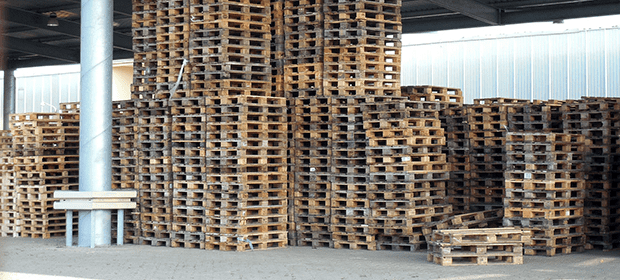As the summer months near closer, now’s the time to put a mould prevention plan into practice. Mould isn’t just unsightly; it can flare up respiratory conditions in workers who are handling the pallets and it poses a contamination risk, which can be especially damaging for pharmaceutical and food or beverage industries.

For mould to grow there needs to be a particular combination of moisture, oxygen, warmth and a source of food. So in order to reduce the risk of mould forming, you need to eliminate one of these factors. What are some of the ways that you can do this? And what should you do if you spot mould growing on any of your pallets? Let’s take a look.
How to prevent mould growing on your pallets
As we mentioned above, to prevent the risk of mould you need to disrupt the conditions that allow it to grow. Since we can’t limit oxygen, and since pallet wood happens to provide the perfect food source for mould, we only really have two factors that we can control in order to prevent mould growth: moisture and temperature. Here are some of the most common ways you can control these, but remember that mould prevention is a continuous strategy that needs to be consistently kept on top of.
Store your pallets correctly
If possible, the best place to store your pallets is in a dry, well-lit and well-ventilated area away from any decaying wood. A temperature of below 15°C is preferable, and – even better- if you can allow space between each row of pallets this will improve airflow. Pallets should be stacked neatly by type/size and never left in a pallet pile!
Don’t leave pallets in shipment longer than they need to be
Dark, warm, humid shipment containers and transport vehicles can be a breeding ground for mould, so make sure you unload your pallets as soon as they’ve reached their destination and move them to a cool, dry, well-ventilated area. Regularly clean your containers and vehicles, and clean up any spillages asap.
Aim to keep the moisture content of your pallets below 20%
Although it isn’t a guarantee, keeping your pallet’s moisture content under 20% reduces the likelihood of mould being able to grow. Kiln-drying your pallets is one of the most effective ways to achieve a low moisture content; the process also kills off any existing mould that may already be on your pallets.
NB: It’s often assumed that heat treating pallets to ISPM15 regulations will prevent mould from growing. Unfortunately, this isn’t the case. ISPM15 heat treatment is different to kiln-drying: it’s designed to kill microorganisms and reduce the risk of them spreading across countries; and whilst it would kill any existing mould, it does not reduce the wood’s moisture content or prevent mould from growing.
Source pallets from a reputable supplier who takes steps to prevent against mould
Even if you have the most effective mould prevention plan in place, you’ll be fighting a losing battle if the pallets you buy already have mould spores forming. Therefore, make sure you source your pallets from a reputable supplier who is just as committed as you to preventing against mould. If you’d like to know more about how our pallets are stored and cared for, please don’t hesitate to get in touch with our customer support team.
What should you do if you notice mould growing on your pallets?
If you notice mould growing on any pallet, it’s important that you isolate it immediately to reduce the risk of the mould spreading and contaminating other pallets or products.
Luckily mould doesn’t generally affect the structural integrity of a pallet, so they are usually salvageable. However, some industries have strict restrictions around mould growth and in some instances the affect pallet will need to be destroyed, so do check with the relevant industry bodies.
To tackle mould, you’ll need to pressure wash the pallet. This will eradicate any visible surface mould. It is also possible to use a bleach solution to kill any surface mould, but this isn’t accepted practice in many industries. After pressure washing your pallet, you’ll need to thoroughly dry it and reduce its moisture content back to below 20% in order to effectively kill all mould spores. Kiln-drying is a good step to help reduce the risk of the mould coming back.
Idle pallets cluttering up the warehouse?
If all this talk of pallet storage has made you realise that you have far too many redundant pallets dotted around, don’t leave them cluttering up the warehouse! Here at Universal Pallets, we’ll collect any good quality, reusable pallets (and pay you for them!) through our pallet collection service. Find out more via our website.
